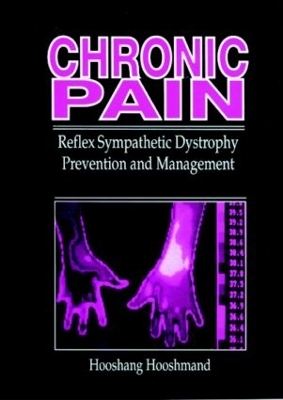
Chronic Pain
Reflex Sympathetic Dystrophy, Prevention, and Management
Seiten
1993
Crc Press Inc (Verlag)
978-0-8493-8667-1 (ISBN)
Crc Press Inc (Verlag)
978-0-8493-8667-1 (ISBN)
More common than previously thought, hyperpathic pain comprises between 10 and 20 percent of chronic pain patients. This book deals with the subject of Reflex Sympathetic Dystrophy (RSD). It classifies the different stages of RSD and describes the qualitative and quantitative differences between natural endorphins and synthetic narcotics.
The most misunderstood and complex subject in medicine is the hyperpathic pain of sympathetic dystrophy. More common than previously thought, it comprises between 10 and 20 percent of chronic pain patients. Understanding this self-perpetuating pain -- which "never stops" -- requires unbiased knowledge of physiology and pathology.
Chronic Pain: Reflex Sympathetic Dystrophy, Prevention, and Management is devoted to the subject of Reflex Sympathetic Dystrophy (RSD). The book classifies the different stages of RSD and describes the qualitative and quantitative differences between natural endorphins and synthetic narcotics. Included are long-term follow-ups on sympathectomy patients.
This important reference explains why sympathectomy fails, but nerve block and physiotherapy is successful in the treatment of RSD. In addition, the mechanism of development of RSD is clarified through an extensive collection of drawings and anatomical pictures as well. Other topics include thermographic methods for the diagnosis of RSD, the role of ACTH in the management of chronic pain, and comparisons between the effects of ACTH and those of corticosteroids.
Features
Classifies the different stages of RSD
Features the most comprehensive coverage of the literature on RSD and its related aspects
Describes qualitative and quantitative differences between natural endorphins and systemic narcotics
Examines the role of ACTH in the management of chronic pain
Clarifies the mechanism of development of RSD through an extensive collection of drawings and anatomical pictures
Explains why sympathectomy fails, but nerve block and physiotherapy is successful in the treatment of RSD
The most misunderstood and complex subject in medicine is the hyperpathic pain of sympathetic dystrophy. More common than previously thought, it comprises between 10 and 20 percent of chronic pain patients. Understanding this self-perpetuating pain -- which "never stops" -- requires unbiased knowledge of physiology and pathology.
Chronic Pain: Reflex Sympathetic Dystrophy, Prevention, and Management is devoted to the subject of Reflex Sympathetic Dystrophy (RSD). The book classifies the different stages of RSD and describes the qualitative and quantitative differences between natural endorphins and synthetic narcotics. Included are long-term follow-ups on sympathectomy patients.
This important reference explains why sympathectomy fails, but nerve block and physiotherapy is successful in the treatment of RSD. In addition, the mechanism of development of RSD is clarified through an extensive collection of drawings and anatomical pictures as well. Other topics include thermographic methods for the diagnosis of RSD, the role of ACTH in the management of chronic pain, and comparisons between the effects of ACTH and those of corticosteroids.
Features
Classifies the different stages of RSD
Features the most comprehensive coverage of the literature on RSD and its related aspects
Describes qualitative and quantitative differences between natural endorphins and systemic narcotics
Examines the role of ACTH in the management of chronic pain
Clarifies the mechanism of development of RSD through an extensive collection of drawings and anatomical pictures
Explains why sympathectomy fails, but nerve block and physiotherapy is successful in the treatment of RSD
Hooshang Hooshmand
Chronic Pain: Reflex Sympathetic Dystrophy, Prevention, and Management is devoted to the subject of Reflex Sympathetic Dystrophy (RSD). The book classifies the different stages of RSD and describes the qualitative and quantitative differences between natural endorphins and synthetic narcotics. Included are long-term follow-ups on sympathectomy patients.
| Erscheint lt. Verlag | 26.3.1993 |
|---|---|
| Zusatzinfo | 58 Tables, black and white; 23 Halftones, black and white |
| Verlagsort | Bosa Roca |
| Sprache | englisch |
| Maße | 178 x 254 mm |
| Gewicht | 580 g |
| Einbandart | gebunden |
| Themenwelt | Medizinische Fachgebiete ► Chirurgie ► Unfallchirurgie / Orthopädie |
| Medizin / Pharmazie ► Medizinische Fachgebiete ► Neurologie | |
| Medizin / Pharmazie ► Medizinische Fachgebiete ► Schmerztherapie | |
| ISBN-10 | 0-8493-8667-5 / 0849386675 |
| ISBN-13 | 978-0-8493-8667-1 / 9780849386671 |
| Zustand | Neuware |
| Haben Sie eine Frage zum Produkt? |
Mehr entdecken
aus dem Bereich
aus dem Bereich
Buch | Softcover (2023)
Urban & Fischer in Elsevier (Verlag)
CHF 85,40
für Studium und Praxis unter Berücksichtigung des …
Buch | Softcover (2022)
Medizinische Vlgs- u. Inform.-Dienste (Verlag)
CHF 39,20


